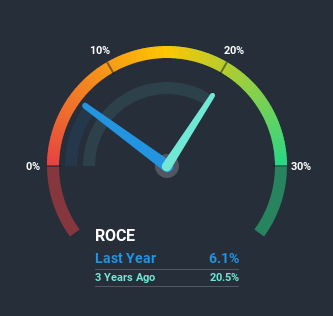- United Kingdom
- /
- Specialty Stores
- /
- LSE:CARD
Is This A Sign of Things To Come At Card Factory (LON:CARD)?
If we're looking to avoid a business that is in decline, what are the trends that can warn us ahead of time? Businesses in decline often have two underlying trends, firstly, a declining return on capital employed (ROCE) and a declining base of capital employed. Basically the company is earning less on its investments and it is also reducing its total assets. So after glancing at the trends within Card Factory (LON:CARD), we weren't too hopeful.
Return On Capital Employed (ROCE): What is it?
For those who don't know, ROCE is a measure of a company's yearly pre-tax profit (its return), relative to the capital employed in the business. To calculate this metric for Card Factory, this is the formula:
Return on Capital Employed = Earnings Before Interest and Tax (EBIT) ÷ (Total Assets - Current Liabilities)
0.061 = UK£29m ÷ (UK£589m - UK£105m) (Based on the trailing twelve months to July 2020).
Thus, Card Factory has an ROCE of 6.1%. In absolute terms, that's a low return and it also under-performs the Specialty Retail industry average of 10%.
View our latest analysis for Card Factory

Above you can see how the current ROCE for Card Factory compares to its prior returns on capital, but there's only so much you can tell from the past. If you're interested, you can view the analysts predictions in our free report on analyst forecasts for the company.
So How Is Card Factory's ROCE Trending?
In terms of Card Factory's historical ROCE movements, the trend doesn't inspire confidence. Unfortunately the returns on capital have diminished from the 20% that they were earning five years ago. Meanwhile, capital employed in the business has stayed roughly the flat over the period. Companies that exhibit these attributes tend to not be shrinking, but they can be mature and facing pressure on their margins from competition. So because these trends aren't typically conducive to creating a multi-bagger, we wouldn't hold our breath on Card Factory becoming one if things continue as they have.
Our Take On Card Factory's ROCE
In summary, it's unfortunate that Card Factory is generating lower returns from the same amount of capital. This could explain why the stock has sunk a total of 84% in the last five years. With underlying trends that aren't great in these areas, we'd consider looking elsewhere.
One more thing, we've spotted 3 warning signs facing Card Factory that you might find interesting.
If you want to search for solid companies with great earnings, check out this free list of companies with good balance sheets and impressive returns on equity.
If you decide to trade Card Factory, use the lowest-cost* platform that is rated #1 Overall by Barron’s, Interactive Brokers. Trade stocks, options, futures, forex, bonds and funds on 135 markets, all from a single integrated account. Promoted
New: AI Stock Screener & Alerts
Our new AI Stock Screener scans the market every day to uncover opportunities.
• Dividend Powerhouses (3%+ Yield)
• Undervalued Small Caps with Insider Buying
• High growth Tech and AI Companies
Or build your own from over 50 metrics.
This article by Simply Wall St is general in nature. It does not constitute a recommendation to buy or sell any stock, and does not take account of your objectives, or your financial situation. We aim to bring you long-term focused analysis driven by fundamental data. Note that our analysis may not factor in the latest price-sensitive company announcements or qualitative material. Simply Wall St has no position in any stocks mentioned.
*Interactive Brokers Rated Lowest Cost Broker by StockBrokers.com Annual Online Review 2020
Have feedback on this article? Concerned about the content? Get in touch with us directly. Alternatively, email editorial-team@simplywallst.com.
About LSE:CARD
Card Factory
Operates as a specialist retailer of cards, gifts, and celebration essentials in the United Kingdom, South Africa, Republic of Ireland, the United States, and internationally.
Undervalued with excellent balance sheet.
Market Insights
Community Narratives




